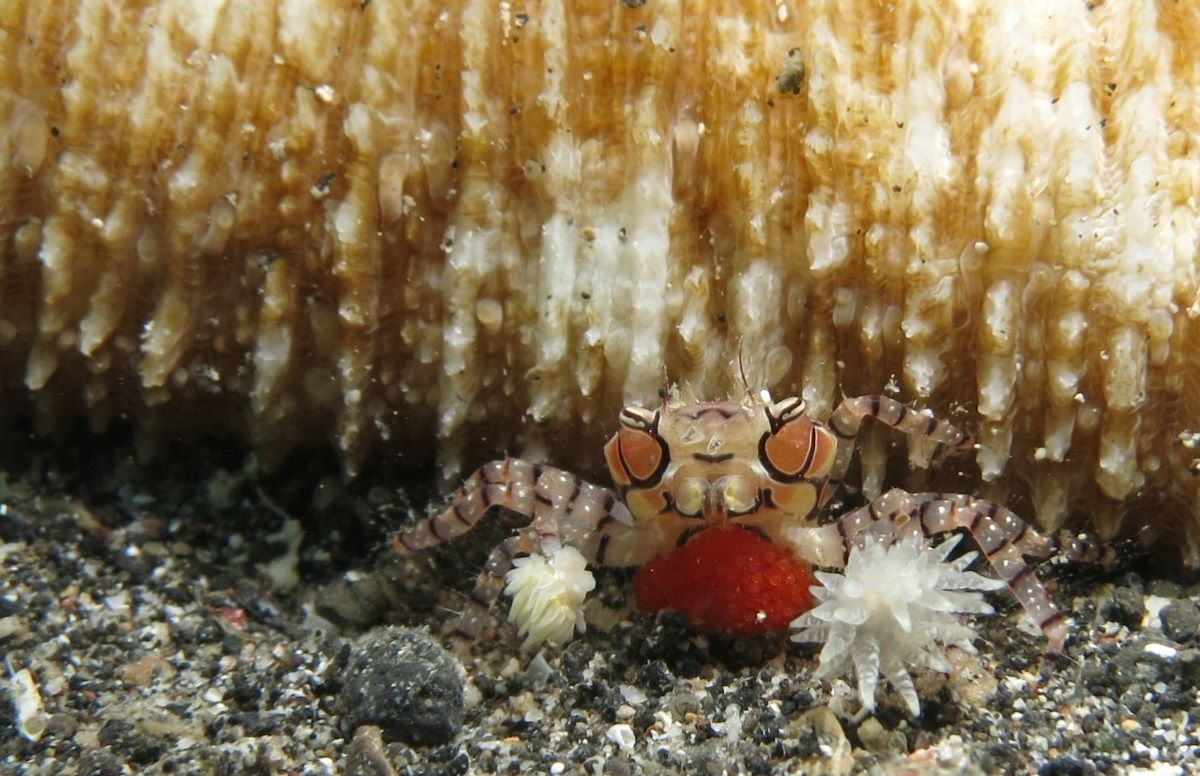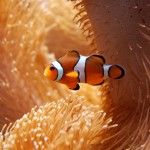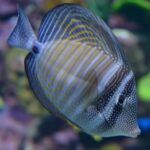If you’ve been following our blog for a bit, you’ll know we love invertebrates. We love shrimp, we love crabs, and heck, we even love the ugly peanut worm. Today, we’re putting the spotlight on one of the most wacky members of the crab department: the tiny pom pom crab of the genus Lybia.
Keep reading for everything you need to know about pom pom crab care and caring for this species in your own aquarium!
| Name (Common, Scientific) | Pom pom crab, boxing crab, boxer crab, cheerleader crab, Lybia sp. |
| Minimum tank size | 5 gallons |
| Minimum group size | 1 |
| Temperature | 72-78 °F |
| Salinity | 1.023-1.025 |
| pH | 8.1-8.4 |
| Difficulty level | Easy |
Pom pom crab description & natural habitat
Description
It’s not difficult to see where the pom pom crab got its name: it really does look like a little cheerleader carrying two poms. These are actually pieces of anemone, which the crab holds in its claws.
The arrangement works mostly for the crab, not so much the anemone. The anemone has stinging tentacles that offer protection, and the crab can use it to mop food particles off the seafloor. According to research, it takes most of the food for itself (this is called kleptoparasitism), leaving just enough for the anemone to prevent it from growing too much, but still keep it alive.
There are 10 species of pom pom crabs out there, all of them quite small. Most commonly seen in the aquarium hobby are Lybia tessellata and L. edmondsoni (the Hawaiian pom pom crab). Neither of these grows to more than an inch in length. Both have beige and orange color-blocked bodies and sport banded legs.
Due to having evolved specifically to hold their anemones, pom pom crabs have small and underdeveloped claws.
Did you know? Lybia tessellata was first described in 1812. French naturalist Pierre André Latreille was clearly fascinated with these tiny crabs: “(…) and one species which, although small, is nevertheless worthy of attention, is the checkered crab. It is pale yellowish and divided into blocks by red lines; it seizes its prey with a viscous material, with which it can coat its claws.”
Voyage pittoresque à l’Île-de-France, au cap de Bonne-Espérance et à l’Ile de Ténériffe
Natural habitat
The genus Lybia is naturally found in the Pacific. Their exact ranges depend on the species, but the species found in the aquarium trade occur in shallow (<65 ft) reefs. Here, they can find corals to use as hides and foraging grounds, plus the anemones they depend on for safety and food.
Other Lybia crabs are found in a range of habitats. One example is Lybia hatagumoana, which has been spotted as far down as 100m (around 330ft) off the coast of Japan. Interestingly, rather than anemones, this species was found to carry tiny nudibranchs (sea slugs)!
Fascinatingly, there’s also a New Caledonian boxer crab species called Tunebia tutelina (synonym Lybia tutelina), which sometimes uses bits of sea cucumber rather than anemones.
Pom pom crab aquarium
Honestly, caring for pom pom crabs in the aquarium is a breeze, making these inverts suitable for beginning as well as more experienced aquarists. Due to their size, they don’t need a large aquarium, so they’re a great choice for a nano set-up.
Any cycled saltwater aquarium of five gallons or up should work well, although a reef environment would be ideal. If you want to keep your pom pom in an ultra-nano set-up, you may be best off going for the Hawaiian species (L. edmondsoni). At 0.5″, it stays smaller than L. tessellata, which can reach a full inch in diameter.
Make sure to offer plenty of hiding and foraging spots in the form of live rock, caves, and more. Pom pom crabs are quite timid. They like to be able to retreat if they feel threatened, particularly around molting time.
Do pom pom crabs need an anemone?
If you bought a pom pom crab and it doesn’t actually have any anemone with it, don’t worry too much. For a bit of background: in the wild, they specifically use Bunodeopsis and Triactis anemones, which are known for their rather potent nematocysts (stinging cells). Triactis in particular gives a very nasty sting.
Although it uses its anemones to feed, the pom pom crab’s survival doesn’t depend on them. Its claws are not very useful, but it can use its other front legs to eat if the need arises.
In the aquarium, your pom pom crab is likely not going to be overly picky. It’s not uncommon for them to pick up pieces of sponge, random coral bits or Zoanthids to use as “boxing gloves” instead. They can even steal anemones from another pom pom crab if you’ve got more than one!
If your crab only has one anemone, it’ll take care of that itself. Like a tiny aquarist, it will frag the anemone to turn it into two.
Did you know? Some pom pom crabs use anemones of the genus Alicia, which so far have never been spotted free-living. They’ve only been seen in combination with the crabs, raising the question of whether they actually occur on their own or not.
Pom pom crab (Lybia sp.) compatibility
Aside from not being demanding at all, another great thing about pom pom crabs is that they’re usually good neighbors. If a fish does bother a pom pom crab, it probably only needs to get bumped with the anemone once to refrain from doing so again!
Do keep in mind that it’s not a great idea to combine these crabs with larger, carnivorous fish species. Despite their boxer attitude and tendency to hide, they’re still pretty small and vulnerable.
You can keep multiple pom pom crabs together. Although they may appear to fight, this behavior has more to do with showing off than actual aggression. They’re very careful not to touch each other with their anemones (likely because they’re too valuable), and their claws are too weak to actually do any damage.
Are pom pom crabs reef safe?
Yes. Although you’d expect a pom pom crab to accidentally bother corals by bumping them with its stinging anemones, this doesn’t actually appear to happen. They’re very careful with their symbionts and therefore considered reef safe.
Did you know? There’s also a freshwater pom pom crab that goes by the same common name. Ptychognathus barbatus is a fully aquatic crab species that sports hairy patches on its claws, which it uses to catch food particles.

Pom pom crab (Lybia sp.) diet
Seeing a pom pom crab feed is a pretty fascinating thing. The crabs use their anemones to “mop” the aquarium floor and surfaces! Particles get stuck in the anemones. Large bits are for the crab, while the anemone receives the smaller dust.
In large aquariums, you probably won’t need to supplement your pom pom crab’s diet. It’ll find plenty of food by itself. In smaller tanks you can offer pretty much anything that sinks. Algae tablets, frozen foods, live foods, nori: whatever you have on hand is fine.
Remember that pom pom crabs usually come out to feed at night in the wild. If you’re worried yours isn’t eating well, you could try feeding while the aquarium lights are out.
Breeding pom pom crabs
Unfortunately, as far as we’re aware, no one has figured out how to breed pom pom crabs in the aquarium. All of them are wild-caught, which is unfortunate and can affect wild populations. Captive crabs will mate and produce eggs, but raising the planktonic larvae to adulthood has proven highly challenging.
What’s known is that pom pom crab females carry eggs for around two weeks after mating. After hatching, the young strike out on their own immediately.
It’s not possible to tell the difference between a male and a female pom pom crab by looking at their claws. The only way to do so easily is by taking a peek at the abdomen, which can be difficult given their size. Females have a much broader belly plate.
Conclusion
A beautiful nano reef aquarium with one or multiple pom pom crabs is a joy to see, especially when you go to take a peek and the crabs come running with their pom poms raised at you!
If you’re dreaming of your own reef aquarium, big or small, we can help. FantaSEA Aquariums designs, builds and maintains aquariums for our happy clients! Contact us here with your ideas.
Sources & further reading
Schnytzer, Y., Achituv, Y., Fiedler, G. C., & Karplus, I. (2022). The Intimate Relationship Between Boxer Crabs and Sea Anemones: What is Known and What is Not. Oceanography and Marine Biology, 495-531. (Pretty much the definitive work on these crabs!)





